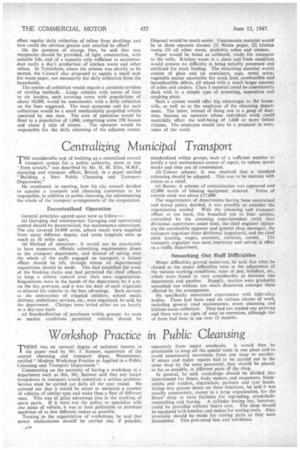Centralizing Munici pal Transport
Page 44

If you've noticed an error in this article please click here to report it so we can fix it.
. .
*THE considerable task of building up a centralized overall transport system for.a public authority, more or less from scratch," waS described by Mr. H. M. Ellis, M.H.E., cleansing and transport officer, Bristol, in a paper entitled "Building a New Public Cleansing and Transport Department."
He mentioned, in opening, how his city council decided toappoint a transport and cleansing committee to be responsible, in addition to public cleansing, for administering the whole of the transport arrangements of the corporation.
Decentralized Operation General principles agreed upon were as follow:— (a) Garaging and maintenance: Garaging and operational control should be decentralized, but maintenance centralized. The city covered 24,000 acres, school meals were supplied from many different depots, and some hospitals were as much as 10 miles apart.
(b) Method of operation; It would not be practicable to have numerous officials submitting requirements direct to the transport department, and instead of taking over the whole of the staffs engaged on transport, a liaison officer should be left, through whom all departmental requisitions should be made. This had simplified the work of the booking clerks and had permitted the chief officers to keep a stricter control over their own organization. Requisitions were in the hands of the department by 4 p.m. on the day previous, and it was the duty of each organizer to allocate his vehicles to the best advantage. Such services as the conveyance of crippled children, school meals delivery, ambulance services, etc., were organized, he said, by the department. Charges were levied either on an hourly or a day-rate basis (c) Standardization of purchases within groups: As soon as market conditions permitted, vehicles should be standardized within groups, each of a sufficient number to justify a unit maintenance system of repair, to reduce spares stocks and time out of commission.
(d) Colour scheme: It was resolved that a standard colouring should be adopted. This was to be maroon with cream as a relief.
(e) Stores: A scheme of centralization was approved and £2,000 worth of binning equipment ordered. Value of current stock Was about £17,000.
The requirements of departments having been ascertained and broad policy decided, it was possible to consider -the organization needed. With the cleansing and transport officer at tne head, this branched out to four spheres, controlled by the cleansing superintendent (with four divisional supervisors under him), the chief engineer (directing the automobile engineer and general shop manager), the transport organizer (four divisional organizers), and the chief clerk (costing. wages, accounts, statistics,. stores). The transport organizer was most important and served, in effect as a traffic department.
Smoothing Out Staff Difficulties Minor difficulties proved numerous, he said, but what he classed as the major difficulties were in the adjustment of the various working conditions, rates of pay, holidays, etc., which were found to vary considerably as between one department and another. Happily, matters were gradually. smoothed out without too much dissension amongst 'those affected by the arrangement.
He specifically mentioned experiments with light-alloy bodies. These bad been used on various classes of work, including general road maintenance, street cleansing and kitchen-waste collection. They had not needed any painting and there were no signs of wear or corrosion, although one of them had been in use over 12 months.












































































